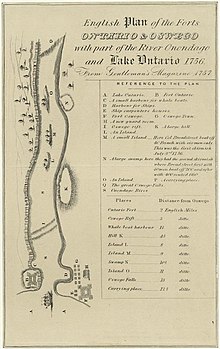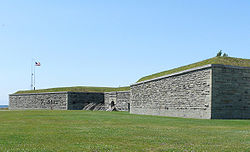Fort Ontario: Difference between revisions
Magicpiano (talk | contribs) images; remove facebook link |
It's "a historic" not "an historic". Get it through your thick head. |
||
| Line 14: | Line 14: | ||
| refnum=70000426<ref name="nris">{{NRISref|2007a}}</ref> |
| refnum=70000426<ref name="nris">{{NRISref|2007a}}</ref> |
||
}} |
}} |
||
'''Fort Ontario''' is |
'''Fort Ontario''' is a historic fort situated by the [[Oswego, New York|City of Oswego]], in [[Oswego County, New York|Oswego County]], [[New York]] in the [[United States|United States of America]]. It is owned by the state of New York and operated as a museum known as '''Fort Ontario State Historic Site'''. |
||
==Geography and early history== |
==Geography and early history== |
||
Revision as of 01:00, 1 May 2011
43°27′57″N 76°30′29″W / 43.46583°N 76.50806°W
Fort Ontario | |
 View from Fort Ontario | |
| Location | Oswego, New York |
|---|---|
| Built | 1839 |
| Architect | Unknown |
| Architectural style | No Style Listed |
| NRHP reference No. | 70000426[1] |
| Added to NRHP | December 18, 1970 |
Fort Ontario is a historic fort situated by the City of Oswego, in Oswego County, New York in the United States of America. It is owned by the state of New York and operated as a museum known as Fort Ontario State Historic Site.
Geography and early history

Fort Ontario is located on the east side of the Oswego River on high ground overlooking Lake Ontario.
Fort Ontario was one of several forts erected by the British to protect the area around the east end of Lake Ontario. The original Fort Ontario was erected in 1755, during the French and Indian War in order to bolster defenses already in place at Fort Oswego on the opposite side of the river. At that time its name was the "Fort of the Six Nations," but the fort was destroyed by French forces and rebuilt by British forces in 1759.
During the American Revolutionary War, a detachment from the 3rd New York Regiment destroyed the fort in July, 1778, after the British abandoned it. The British returned and rebuilt the fort in 1782. There was an aborted attack on the fort by Colonel Marinus Willet in 1783. The British held the fort after the war was over until 1796 after the signing of Jay's Treaty.
Nineteenth century
The fort was attacked and destroyed by British forces during the War of 1812 in the year 1814. After a period of disuse, new construction was undertaken in part due to tensions with Great Britain as well as to check smuggling activities between Canada and the United States.
During the American Civil War the new construction began at the fort due to fear of British help from Canada to the South. Although the fort remained a military base, the fort itself fell into ruin, since funds were used to create more modern quarters outside the fort.
The modern fort
2nd Brigade of the U.S. 1st Infantry Division called Fort Ontario home until the brigade was inactivated on June 1, 1940.

During World War II, Fort Ontario was home to approximately 982 Jewish refugees, from August 1944 to February 1946. Fort Ontario was the first and only attempt by the United States to shelter Jewish refugees during the war. After the end of the war the refugees were kept in internment due to disagreements concerning whether or not to allow them to become United States citizens. In January 1946, the decision was made to allow them to become citizens, and by February all of the Jewish refugees were allowed to leave Fort Ontario.
The restored fort is open to the public as a state historic site. It was listed on the National Register of Historic Places in 1970.[1] In 2010, Fort Ontario was one of the state-funded historical sites named by Governor David Paterson as being potentially unfunded due to the budget crisis faced by New York State. In response, many of the citizens of Oswego and students of the State University of New York at Oswego have joined together in support of the historical site.
Fort Ontario was built with two other forts in the period, Fort George and Fort Oswego.
References
- ^ a b "National Register Information System". National Register of Historic Places. National Park Service. January 23, 2007.
- Graymont, Barbara, The Iroquois in the American Revolution, 1972, ISBN 0-8156-0083-6
External links
- American Revolutionary War forts
- Forts in New York
- French and Indian War forts
- New York state historic sites
- Military facilities on the National Register of Historic Places in New York
- Museums in Oswego County, New York
- Military and war museums in New York
- Living museums in New York
- British forts in the United States
- Colonial forts in New York
- Jewish American history

